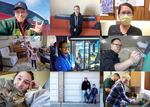
These are the faces of some of the dozens of Northwest residents who shared stories of life during COVID-19 with OPB this year.
Supplied photos / OPB
When COVID-19 restrictions arrived in Oregon, OPB began to pull together short videos illustrating how the pandemic was reshaping life across the region.
The result, “Postcards from the Pandemic,” is now a series of text, audio and video stories told across OPB’s digital and broadcast platforms.
We visited a nurse at Oregon Health & Science University’s intensive care unit, heard from high-school students whose senior year was cut short and listened to working people who suddenly found themselves unemployed and struggling to make ends meet.
Inspiration and disruption for artists at work
In many of our explorations, we dove into how the lives of working artists were transformed by the coronavirus. As they coped with financial hardship and isolation, these artists often also found an opportunity to create new work that reflects our unprecedented times.
”Oregon Art Beat” featured eight of their stories for a broadcast television episode that sheds insight into the year that is drawing to a close. Watch below.
Here are more highlights from OPB’s “Postcards from the Pandemic” series:
Children’s routines upended by new restrictions
Without access to school buildings, classrooms or playgrounds, kids faced long days at home, with seemingly no end in sight. “I miss recess. I miss my friends. I miss lunchtime. And I also really miss my teacher,” said 6-year-old Reed from Bend, who shared her thoughts on the pandemic. Listen to Reed and other Oregon children in this piece from March 30:
On the front-lines, a mixed blessing for those still able to work
“I have one N-95 mask and we’re told to use it until it’s no longer structurally sound,” said home health and hospice nurse Giselle Faux, who faced personal protective equipment shortages in the early days of the pandemic. “Oh no — not one mask a day, I have one mask. One mask. Period. It’s sitting in my car in a little box. .... Sometimes you just have to refocus on what you’re doing right, instead of what’s going wrong.”
TriMet driver Craig Hill on life behind the wheel of a city bus: “It’s not easy to expose yourself, and also, because you’re exposing yourself, that means you’re exposing your family. But at the same time, I am glad that I have a job.”
“It’s dangerous to have these public services and to be inviting people into a very small contained space with me. Each day I take my temperature and throughout the day I check to make sure I’m not running a fever,” said Tawasi Soce, who drove for ride-sharing services, delivers food and accepted other gig driving opportunities at the start of the pandemic.
“Doing ride-share, the demographic of passenger has changed. Typically, I would be picking people up from the fancy hotels downtown and driving them to the airport,” Soce said. “Now I just don’t see those business workers anymore, I don’t see the fancy people. The people who I end up driving around now are blue-collar workers, people who are janitors or food-service workers. It’s really strange to see such a dramatic shift in passengers. The poor people, we have to keep working. We can’t just sit at home and isolate.”
Ride-sharing opportunities dried up as the pandemic stretched out and Soce said he switched to more restaurant and warehouse deliveries.
Fighting for her life
Baby Brave Bear was born in February, just as the coronavirus began to spread in the U.S.
He weighed around 12 pounds when he tested positive for COVID-19 at the age of 2 months. Bonita Leonard remembers her son’s screams, as nurses tried unsuccessfully to catheterize him, and she remembers her own tears as the family was separated for the first time.
A week later, Leonard was fighting for her own life.
Leonard resisted going to the hospital when she became ill: “If I die, that’s not how I want to die. I want to be around my family. I want to be able to tell them I love them. What if I went to the hospital and couldn’t fight because I felt so alone?”
A video collection of lives reshaped by COVID-19
In a series of videos, our “Postcards from the Pandemic” stories highlight emergency managers’ efforts to keep firefighters safe during wildfire season, the challenges of feeding tribal elders, addiction recovery efforts interrupted, virtual religious services, agricultural workers whose lives were upended and many other stories about how life in 2020 was upended by the coronavirus. Watch the whole playlist on YouTube.
